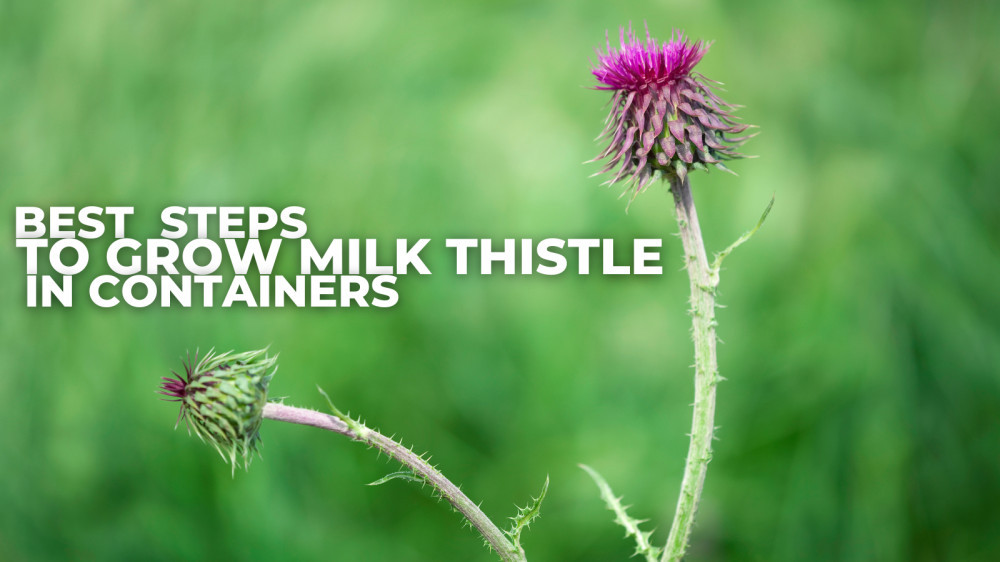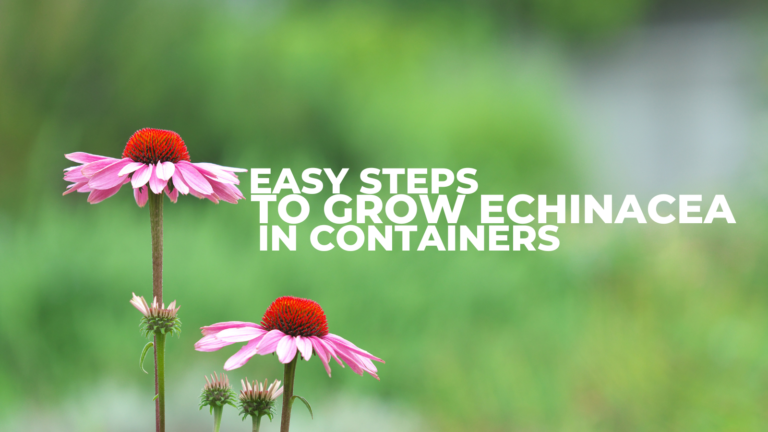Best Steps To Grow Milk Thistle In Containers
Best Steps To Grow Milk Thistle In Containers
A challenging plant is the milk thistle, sometimes known as the silybum milk thistle. Though exceedingly invasive and prized for its therapeutic qualities.
Some places are targeting it for elimination. Ideally, continue reading for details on how to grow milk thistle in containers.
Does Milk Thistle Have Medicinal Value?
Yes, milk thistle has been shown to have medicinal benefits, but more study is required. Most current research only uses silymarin, the primary milk thistle compound, rather than the entire seed, and the potential synergies between the complete compounds found therein complicate matters.
People have used milk thistles for thousands of years to treat various illnesses, particularly liver issues.
Milk thistle has a wide range of health and medicinal benefits, which modern science is starting to demonstrate.
History & Origin Of Milk Thistle
The plant milk thistle (Silybum marianum or Cardus marianum) cures various ailments, including liver conditions and breastfeeding issues.
The plant's ripe seeds contain silymarin, the herb's active component. Long stems, green leaves with white dots, and a spikey head of pink to purple flowers are all features of the milk thistle plant (which, true to its name, resembles a thistle).
The plant is indigenous to Europe and can also be found growing naturally in North and South America.
Other frequent names for the plant include Mary thistle, St. Mary thistle, Marian thistle, and Lady's thistle.
For over 2,000 years, milk thistle's therapeutic properties have been treasured. According to written accounts, Romans used the herb as a liver protector as early as the first century.
Throughout the Middle Ages, the plant was also widely used, and the medical benefits of milk thistle seeds were first mentioned in the herbal literature of this time.
British herbalist Nicholas Culpepper wrote about the herb's benefits in treating liver and spleen conditions in the late eighteenth century.
Documents reveal that American doctors were also dispensing the drug by the end of the following century. German researchers initially extracted silymarin from the milk thistle plant in the 1960s.
The milk thistle plant's leaves and stems are edible and can be used in salads or eaten raw. The plant was grown in Europe as a vegetable through the final decades of the nineteenth century.
Health Benefits Of Milk Thistle
While some people believe milk thistle can prevent or treat high cholesterol, diabetes, heartburn, an upset stomach (dyspepsia), hangovers, gallbladder issues, menstrual pain, depression, and even some types of cancer, the herb is most frequently used to treat liver conditions like hepatitis and cirrhosis. Few of these assertions are backed up by concrete proof.
Here are some findings from recent research:
1. Protect From Liver Disease
According to some early research, Silymarin may enhance liver function by preventing harmful chemicals from adhering to liver cells.
However, studies on the efficacy of milk thistle in treating liver problems have shown conflicting results.
According to several smaller trials, milk thistle may be helpful for persons with mild, subacute (symptom-free) liver disease.
An early Finnish study indicated that four weeks of silymarin supplementation decreased critical liver enzymes in patients with subacute illness, indicating that the liver was operating more normally.
Despite the promising results, further research has not been able to confirm them or show that milk thistle alone would have the same effects.
2. Helps Chronic Hepatitis C
Some persons with chronic hepatitis C utilize milk thistle (a viral infection characterized by progressive scarring of the liver).
A study supported by the National Institutes of Health found that milk thistle was the most popular herbal supplement, utilized by 23% of the 1,145 persons with hepatitis C.
This was validated by a 2012 study in the Journal of the American Medical Association (JAMA).
Silymarin, taken thrice daily in 420 or 700 milligrams doses, was well accepted by research participants but had no discernible impact on liver enzymes.
Given these inconsistencies, many scientists think milk thistle has a placebo-like effect, causing people to experience relief from their symptoms even when their clinical condition hasn't changed.
3. Good For Type 2 Diabetes
According to several studies, milk thistle may help people with diabetes, especially type 2 diabetes.
A 45-day course of silymarin enhanced antioxidant capacity and decreased generalized inflammation in persons with type 2 diabetes more effectively than a placebo, according to 2015 research published in Phytomedicine.
The study's authors claim that the results imply that silymarin may lessen the oxidative stress generally connected to the consequences of diabetes.
4. Regulate Blood Sugar
Milk thistle improves metabolic health by regulating insulin sensitivity and blood sugar levels.
High glucose concentrations in specific tissues can produce sorbitol buildup due to the enzyme aldose reductase (e.g., which helps maintain metabolic health throughout the body.
Daily blood sugar balancing advantages are acceptable, but those with blood sugar health issues should consult their doctor to determine whether a milk thistle supplement suits their particular requirements.
5. Nurtures Skin Health
Thanks to its oxidative stress-neutralizing properties, milk thistle is an excellent booster of precise, healthy skin throughout all stages of life.
According to a 2019 Molecules review, silymarin has anti-collagenase and anti-elastase activity, which prevents collagen breakdown and fosters skin strength and elasticity.
Silymarin also acts as a bulwark against the harmful effects of full-spectrum solar radiation (aka UV rays from the sun).
According to Robinett, a tincture made from the seed, burdock seed, and omega-3 fatty acids can nourish and moisturize skin. Even some skin care products use it. What is it not able to do?
6. Fight Acne
Have acne problems? The antioxidant qualities of silymarin may assist in improving the efficacy of other known therapies.
Acne lesions were reduced in those who took 100 milligrams of doxycycline and 140 milligrams of silymarin daily for 8 weeks.
The advantages of combining silymarin with doxycycline aren't entirely evident because using doxycycline alone also reduces acne.
7. Boost Breast Milk Production
According to limited research, Silymarin may promote the body to produce more prolactin, the hormone that produces breast milk.
The negative? The safety of using milk thistle during nursing is not entirely established. As a result, you should discuss it with your doctor before using it.
8. Good For Asthma Patients
Nobody has investigated how milk thistle affects human asthma. However, one study found that silymarin treatment reduced airway inflammation in asthmatic mice compared to control animals.
9. Boost Immune System
One's immune system could be strengthened with milk thistle. It could lessen chronic immune system-induced inflammation and aid the body's defences against infection.
According to several studies, milk thistles may have immunomodulatory properties. Silymarin stimulates the immune system.
Additionally, it slows down an overactive immune system to reduce the chronic inflammation linked to diseases like asthma and allergic rhinitis.
A 2016 human model study discovered that milk thistle extracts enhanced immunity. An earlier investigation also discovered that milk thistle extract improved human immune response.
More research involving human subjects might enable researchers to confidently say that milk thistle helps a person's immune system.
How To Grow Milk Thistle In Containers
Milk thistle is a hardy annual plant that grows wild in rocky, arid places. It is native to Europe but is also found in North America.
Although it is frequently seen as an invasive weed, milk thistle has gained popularity. It is now a frequent addition to many gardens and backyards because of its advantages for liver health.
The growing instructions provided here provide helpful guidance on how to grow and maintain milk thistle at home.
1. Best Location To Grow Milk Thistle
Although it is not native to North America, milk thistle tends to thrive in climate zones 6 to 9. Protecting it from frost is unnecessary because it is exceptionally frost-resistant.
Plants rapidly self-sow even if they die off in the winter (which will happen in colder zones). Inevitably, new plants will come back the following year. These positive traits also contribute to milk thistle plants' invasiveness.
2. Choose The Right Container To Grow Milk Thistle Plants
You won't experience any issues if you buy it in nursery pots or containers and plant it in the spring or at the start of the summer.
I prefer a location with full sun or some shade for the specimens, which should be separated by around 16 inches of space (30 cm).
Grow herbs, flowers, or veggies in containers with sufficient drainage for the best results. Although wooden or plastic pots can have drainage holes installed, most already have them.
3. Soil To Grow Milk Thistle In Containers
The milk thistle may flourish in various soil conditions, including sand and dense clay. Most types of soil, including impoverished soil, can support the growth of milk thistle in gardens.
Almost minimal weed treatment is required because milk thistle is frequently regarded as a weed in and of itself.
After the last frost, sow your seeds 14 inches (5 mm) deep in an area that receives full sun.
Although milk thistle is a resilient plant that thrives in various situations, it favours hot and dry weather. The only prerequisite for milk thistle is soil with good drainage.
4. Grow Milk Thistle From Seeds
For summer flowering, milk thistle seeds should be planted about ½ inch deep outside in a container or the ground in either March or April.
You only need three or four seeds per hole; each should be about three feet apart. After the seedlings have germination, which should take between 10 and 20 days, the weakest plants can be thinned out.
5. Sunlight Requirements For Milk Thistle Plants
The optimal growing conditions for the milk thistle plant are either full sun or partial shade. Partial shade is acceptable, but full sun is preferable.
6. Watering
The milk thistle plant thrives in dry environments and is drought-tolerant. Without a highly severe drought, it shouldn't require any watering.
While seed germination can benefit from light watering, this practice should end after seedlings emerge from the soil's surface. Indoor seedlings need to be treated like cacti and only need a little water once every week.
7. Temperature And Humidity
The tough milk thistle plant does not particularly reflect the weather in which it will grow. Their seeds can start growing in various temperatures between 32° and 86°F, and the plant can survive up to 10 years.
8. Pruning Of Milk Thistle
As soon as the milk thistle's blossoms begin to fade, the top stems can be clipped if you planted them to add a touch of colour to your landscape. This will improve the plant's overall appearance and help limit the wind's dissemination of seeds.
9. Weed Control
The milk thistle plant is sometimes seen as a weed. To control its spread, collecting the seeds before they reach full maturity is advised.
Mulching around the plant is advised to stop reseeding. A little light maintenance, especially while the plant is young, should be sufficient to control overgrowth because milk thistle competes well with other plants.
10. Common Pests And Other Problems Of Milk Thistle
Milk thistle doesn't cause too many issues as a weed. Other plants typically have this issue! Slugs and snails, however, are frequently drawn to their weedy growth.
However, most sources designate milk thistle as a pest, so think twice before including it in your garden.
Several jurisdictions use an insect known as the thistle-head weevil to manage milk thistle plants.
The thistle plant's seeds are eaten by its larvae, stopping it from self-sowing. Unfortunately, this beetle will attack many noninvasive thistle species in addition to milk thistle.
11. Harvesting Milk Thistle
Before handling it, you must wear heavy gardening gloves because of their spiky nature. The leaves have sharp spines that can pierce the flesh, making them very prickly.
When the blossoms dry out and form silvery-white seed heads known as pappus, they are ready to be harvested.
Although plants frequently mature at various periods, seed production usually begins in the fall.
- Cut the milk thistle blossoms off the plant at the base of the flower head once they have dried.
- The flower heads should be placed in a paper bag and left in a warm area to dry, which usually takes five to seven days.
- Once the flower heads have completely dried, put them in a burlap bag. Shake the bag thoroughly to separate the seeds, then press down with your palms on the flower heads to separate them further.
- Pour the seeds from the burlap sack into the bucket and place them on the ground outside. Unwanted chaff should blow away as you pour them in, but if some end up in the bucket, pick it out and throw it away.
- Until you're ready to use them, keep the milk thistle seeds in an airtight container in an excellent, dark location.
Uses And Effects Of Milk Thistle
Herbal medicine uses milk thistle fruit to treat digestive issues, toxic liver damage from alcohol, and liver diseases like cirrhosis.
The fruit can be found in pastilles, capsules, and powder made from ground fruit and is frequently a component of blends that stimulate the liver and gall bladder, such as liver tonic.
Whole seeds are commonly crushed in a mortar and pestle before brewing them into milk thistle tea with hot water. The maximum recommended daily intake of milk thistle fruit is 12 to 15 g.
Silymarin is the primary component of milk thistle, and it has liver and digestive benefits. Even in acute poisoning from the tuberous leaf fungus, silymarin is used as a life-saving infusion.
When appropriately used, milk thistle has no known adverse side effects. The fatty seeds of milk thistle can also be used to extract the oil, which has a high level of antioxidants and, as a result, protects cells.
How Is Milk Thistle Tea Made?
Making milk thistle tea is very simple. This is how:
- Use a clean coffee grinder (or mortar and pestle) to grind the whole milk thistle seeds into powder.
- Use about 1 tablespoon of milk thistle seed powder for each cup of tea. Add ground seeds to the tea ball.
- Stirring occasionally, pour nearly boiling water into the cup with the tea ball. Let steep for 5 minutes.
- Use your preferred sweetener to sweeten to your taste (or not at all).
Taste Of Milk Thistle Tea
An upset stomach can tolerate the tea's mildly sweet and milky flavour. Dandelion tea and milk thistle tea are frequently contrasted in terms of flavour. Both varieties of medicinal teas have an “earthy” aftertaste and a faint floral flavour.
Usually, milk, honey, or both are used to sweeten milk thistle tea to have a creamier texture and flavour.
Both fresh and dried loose-leaf milk thistle tea can be used to make tea and are available for purchase.
Although traditional tea bags are available for this tea, many foragers and herbalists dry and powder the seeds before brewing the beverage.
Conclusion
Due to its anti-inflammatory and antioxidant properties, milk thistle has been used as a natural remedy for various illnesses for over 2,000 years.
In 40 A.D., Greek physician and botanist Dioscorides was the first to write about its curative properties. So don’t miss adding the herb to your container garden.
I trust you enjoyed this article on the Best Steps To Grow Milk Thistle In Containers. Please stay tuned for more blog posts to come shortly. Take care!
JeannetteZ
>>>Please click here to read my all-inclusive article, About The Essential Companion Planting Guide<<<
>>>Please click here to read my all-inclusive article about Container Gardening<<<
>>>Are you interested in homegrown herbs and medicine? Please click here to find out more about it!<<<
Your Opinion Is Important To Me
Do you have thoughts, ideas, or questions? I would love to hear from you. Please leave me your questions, experiences, and remarks about this article on the Best Steps To Grow Milk Thistle In Containers in the comments section below. You can also reach me by email at Jeannette@Close-To-Nature.org.
Disclosure
This post may contain affiliate links. As an Amazon Associate and other affiliate programs, I earn from qualifying purchases at no extra cost to you. Read my full affiliate disclosure.
You might also enjoy these blog posts:
Best Steps To Grow Ginseng In Containers
Easy Steps To Grow Celery In Containers
Easy Steps To Grow Goldenseal In Containers
Easy Steps To Grow Feverfew In Containers
Easy Steps To Grow Ginkgo In Containers
















